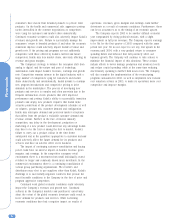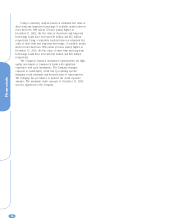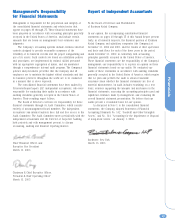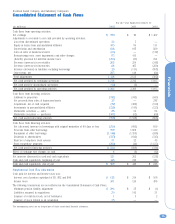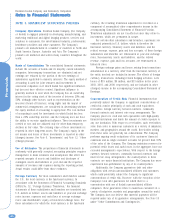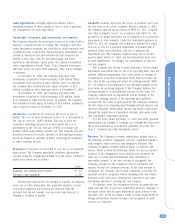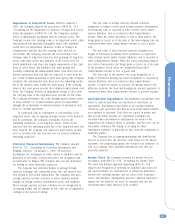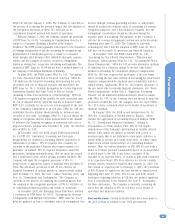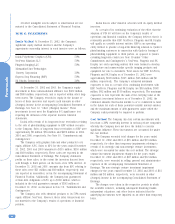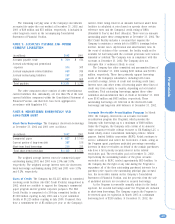Kodak 2002 Annual Report Download - page 45
Download and view the complete annual report
Please find page 45 of the 2002 Kodak annual report below. You can navigate through the pages in the report by either clicking on the pages listed below, or by using the keyword search tool below to find specific information within the annual report.
Financials
45
Cash Equivalents All highly liquid investments with a
remaining maturity of three months or less at date of purchase
are considered to be cash equivalents.
Marketable Securities and Noncurrent Investments
The Company classifies its investment securities as either held-to-
maturity, available-for-sale or trading. The Company’s debt and
equity investment securities are classified as held-to-maturity and
available-for-sale, respectively. Held-to-maturity investments are
carried at amortized cost and available-for-sale securities are
carried at fair value, with the unrealized gains and losses
reported in shareholders’ equity under the caption accumulated
other comprehensive income (loss). If the Company determines
that such losses are other than temporary, they will be charged
to earnings.
At December 31, 2002, the Company had short-term
investments classified as held-to-maturity of $9 million. These
investments were included in other current assets. In addition,
the Company had available-for-sale equity securities of $24
million, included in other long-term assets at December 31, 2002.
At December 31, 2001, the Company had short-term
investments classified as held-to-maturity of $3 million, which
were included in other current assets. In addition, the Company
had available-for-sale equity securities of $33 million, included in
other long-term assets at December 31, 2001.
Inventories Inventories are stated at the lower of cost or
market. The cost of most inventories in the U.S. is determined by
the “last-in, first-out” (LIFO) method. The cost of all of the
Company’s remaining inventories in and outside the U.S. is
determined by the “first-in, first-out” (FIFO) or average cost
method, which approximates current cost. The Company provides
inventory reserves for excess, obsolete or slow-moving inventory
based on changes in customer demand, technology developments
or other economic factors.
Properties Properties are recorded at cost, net of accumulated
depreciation. The Company principally calculates depreciation
expense using the straight-line method over the assets’ estimated
useful lives, which are as follows:
Years
Buildings and building improvements 10– 40
Machinery and equipment 3 – 20
Maintenance and repairs are charged to expense as incurred.
Upon sale or other disposition, the applicable amounts of asset
cost and accumulated depreciation are removed from the
accounts and the net amount, less proceeds from disposal, is
charged or credited to income.
Goodwill Goodwill represents the excess of purchase price over
the fair value of net assets acquired. Effective January 1, 2002,
the Company adopted the provisions of SFAS No. 142, “Goodwill
and Other Intangible Assets.” In accordance with SFAS No. 142,
goodwill is no longer amortized, but is required to be assessed for
impairment at least annually. Under the transitional guidance of
SFAS No. 142, the Company was required to perform two steps,
step one to test for a potential impairment of goodwill and, if
potential losses were identified, step two to measure the
impairment loss. The Company completed step one in its first
quarter ended March 31, 2002 and determined that there were
no such impairments. Accordingly, the performance of step two
was not required.
The Company has elected to make September 30 the annual
impairment assessment date for all of its reporting units, and will
perform additional impairment tests when events or changes in
circumstances occur that would more likely than not reduce the
fair value of the reporting unit below its carrying amount. SFAS
No. 142 defines a reporting unit as an operating segment or one
level below an operating segment. If the Company believes the
carrying amount of a reporting unit exceeds its fair value, the
Company would record an impairment loss in earnings to the
extent the carrying amount of the reporting unit’s goodwill
exceeded the fair value of such goodwill. The Company estimates
the fair value of its reporting units through internal analysis and
external valuations, which utilize income and market approaches
through the application of capitalized earnings, discounted cash
flow and market comparable methods.
For the years ended December 31, 2001 and 2000, goodwill
amortization was charged to earnings on a straight-line basis over
the period estimated to be benefited, generally ten years. See
Note 5, “Goodwill and Other Intangibles Assets.”
Revenue The Company’s revenue transactions include sales of
the following: products; equipment; services; equipment bundled
with products and/or services; and integrated solutions. The
Company recognizes revenue when realized or realizable and
earned, which is when the following criteria are met: persuasive
evidence of an arrangement exists; delivery has occurred; the
sales price is fixed and determinable; and collectibility is
reasonably assured. At the time revenue is recognized, the
Company provides for the estimated costs of warranties and
reduces revenue for estimated returns. At the time revenue is
recognized, the Company also records reductions to revenue for
customer incentive programs offered including cash and volume
discounts, price protection, promotional, cooperative and other
advertising allowances, slotting fees and coupons.
For product sales, the recognition criteria are generally met
when title and risk of loss have transferred from the Company to
the buyer, which may be upon shipment or upon delivery to the
customer sites, based on contract terms or legal requirements in
foreign jurisdictions. Service revenues are recognized as such
services are rendered.



